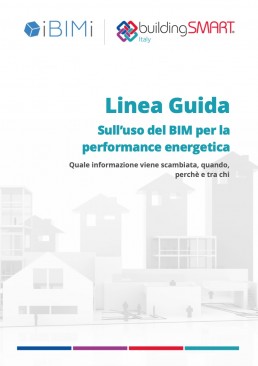Linea guida sul BIM per la performance energetica: Quali informazioni scambiare, quando, perchè e tra chi.
Questa linea guida contiene spunti di riflessione per concepire un patrimonio edilizio più sostenibile. L’edilizia tradizionale deve lasciare il passo a un approccio più moderno. Il progetto preliminare non può solo guardare al progetto come fine a se stesso ma deve essere concepito come un passo in un ciclo continuo. Ciò significa che l’autore del progetto preliminare deve considerare le conseguenze della sua decisione durante tutto il ciclo di vita dell’edificio. Per fare al meglio il suo lavoro deve condividere le informazioni e le decisioni con tutti gli attori della ristrutturazione dell’edificio.
L’opera è frutto di numerose collaborazioni a livello nazionale ed internazionale. Il contributo principale è venuto dal gruppo di lavoro nazionale su Efficienza Energetica, composto da aziende e professionisti membri del capitolo italiano buildingSMART e da due principali stakeholders: Agenzia del Demanio e Ministero per lo Sviluppo Economico (MISE).
La linea guida qui pubblicata rappresenta solo una delle numerose possibilità per identificare quali informazioni devono essere scambiate durante la vita di un edificio per raggiungere le migliori prestazioni. Nel caso di un piccolo edificio o di un singolo appartamento, i processi possono essere semplificati e molti scambi saranno affidati a meno attori mentre, nel caso di edifici complessi, i ruoli identificati in questa linea guida possono essere ancora suddivisi tra più attori . Ciò che si è cercato di sottolineare è l’importanza di disporre di informazioni affidabili per prendere decisioni consapevoli, e per gestire l’edificio per il resto della sua vita che, in alcuni casi, sarà per sempre.
Siamo aperti ai contributi di qualsiasi esperto disposto a condividere le sue conoscenze per migliorare questa linea guida.
Guide line on the use of BIM for energy performance: What information is exchanged, when, why and between whom.
This guideline contains food for thought to conceive a more sustainable building stock. Traditional construction must give way to a more modern approach. The preliminary project cannot only look at the project as an end but must be conceived as a step in a continuous cycle. This means that the author of the preliminary project must consider the consequences of his decision throughout the life cycle of the building. To do his job in the best possible way, he must share information and decisions with all those involved in the renovation of the building.
The work is the result of numerous collaborations at national and international level. The main contribution came from the national working group on Energy Efficiency, made up of companies and professionals who are members of the Italian buildingSMART chapter and two main stakeholders: the State Property Agency and the Ministry for Economic Development (MISE).
The guideline published here represents only one of several possibilities for identifying what information must be exchanged during the life of a building to achieve the best performance. In the case of a small building or a single apartment, the processes can be simplified, and many exchanges will be entrusted to fewer actors while, in the case of complex buildings, the roles identified in this guideline can still be divided among several actors. What we tried to emphasize is the importance of having reliable information to make informed decisions, and to manage the building for the rest of his life which, in some cases, will be forever.
We are open to contributions from any expert willing to share their knowledge to improve this guideline.
Compila il form per ricevere il PDF: “Guide line on the use of BIM for energy performance: Quali informazioni scambiare, quando, perchè e tra chi.”

Fill out the form to receive the PDF: “Guideline on the use of BIM for energy performance. Which information is exchanged, when, why, and among who”